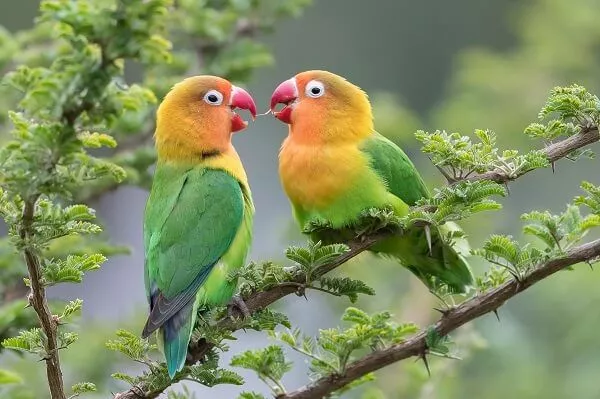Discover the intriguing world of lovebirds and explore the age-old question: Do Lovebirds Have to Be Kept in Pairs? Uncover the facts.
Introduction
Welcome to the world of lovebirds, these charming and captivating avian companions have earned a special place in the hearts of many. Lovebirds are known for their vibrant plumage, endearing behaviors, and, of course, their strong desire for social interaction. we will delve into the fascinating world of lovebirds, understanding their social nature, and explore the central controversy: Do lovebirds need to be kept in pairs?
Understanding Lovebirds: Do Lovebirds Have to Be Kept in Pairs
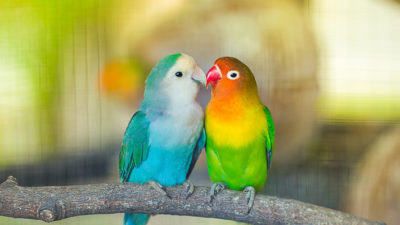
Lovebirds, scientifically classified as Aquaporins, are small parrots native to the African continent. They are appropriately named due to their affectionate and loving behaviors, often forming deep bonds with their mates. These birds come in various species, including the Peach-faced Lovebird, Fischer’s Lovebird, and the Masked Lovebird, each with its distinctive plumage and characteristics.
The Social Nature of Lovebirds
Lovebirds are renowned for their highly social nature. In the wild, they are found in flocks, and these avian communities are characterized by their close-knit relationships. These birds thrive on companionship and are known for their affectionate interactions with their fellow lovebirds.
Fascinating Behaviors
Lovebirds exhibit an array of captivating behaviors, such as preening, feeding one another, and engaging in soft, melodious chatter. These behaviors are not only endearing but also highlight the strong social bonds that form between them.
The Controversy: Do Lovebirds Need to Be Kept in Pairs?
A significant debate in the world of lovebird care revolves around whether these birds should always be kept in pairs or if they can thrive as singles. Traditionally, it was believed that lovebirds should always have a companion of their kind to ensure their well-being and happiness. This belief stems from the observation of lovebirds’ behavior in the wild, where they are almost always seen with their flock.
The Importance of Social Interaction
Proponents of keeping lovebirds in pairs argue that the social interaction and companionship provided by a mate are crucial for their mental and emotional health. They believe that a solitary lovebird may suffer from loneliness, which can lead to stress and behavioral issues.
Challenging the Convention
On the other hand, there is a growing perspective that challenges this traditional belief. Some argue that lovebirds can adapt to a solo life and even form strong bonds with their human caregivers. The controversy arises from the varying experiences and opinions of lovebird owners, avian specialists, and breeders.
we will explore the different sides of this debate, shedding light on the arguments for and against keeping lovebirds in pairs. By the end of this comprehensive article, you will be equipped with the knowledge to make an informed decision about the care of your lovebird companion.
Lovebird Social Behavior
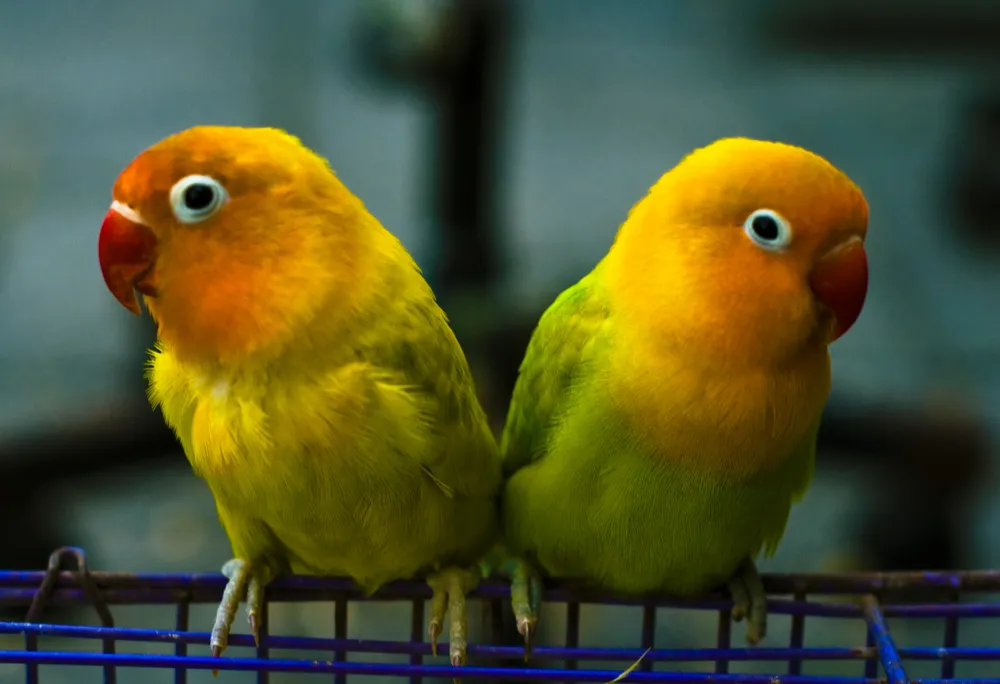
In this chapter, we delve into the fascinating social behavior of lovebirds. Understanding their natural inclinations and tendencies is crucial when exploring the question of whether they need to be kept in pairs.
Lovebirds: Naturally Social Creatures
Lovebirds, as their name implies, are inherently social birds. In their natural habitat, they are often observed in flocks, where they engage in a variety of social interactions. Here are some key aspects of their social behavior:
Flocking Behavior
Lovebirds are known for their strong flocking instinct. They feel most comfortable and secure when they are in the company of their own kind. This instinct is deeply ingrained in their genetic makeup.
Affectionate Bonds
Within a lovebird flock, these birds form strong and affectionate bonds with one another. They are often seen preening each other, sharing food, and engaging in gentle grooming. These behaviors are manifestations of their deep social connections.
Vocal Communication
Lovebirds are not only social in their actions but also in their vocalizations. They use a range of chirps, squawks, and melodic sounds to communicate with each other within the flock.
The Significance of Social Interaction
Understanding the importance of social interaction for lovebirds is crucial to address the question of whether they need to be kept in pairs.
Mental Stimulation
Social interaction provides lovebirds with mental stimulation, preventing boredom and the development of negative behaviors.
Emotional Well-being
For lovebirds, companionship is not just a luxury; it’s a necessity for their emotional well-being. They thrive on the company of their flockmates.
Physical Health
Healthy social interaction also contributes to the overall physical health of lovebirds. It helps in maintaining their plumage, as they engage in mutual grooming, and it ensures they have a balanced diet by sharing food.
As we explore this topic further, we will consider how these natural behaviors in the wild translate into domestic settings and whether they necessitate keeping lovebirds in pairs.
The Argument for Keeping Lovebirds in Pairs
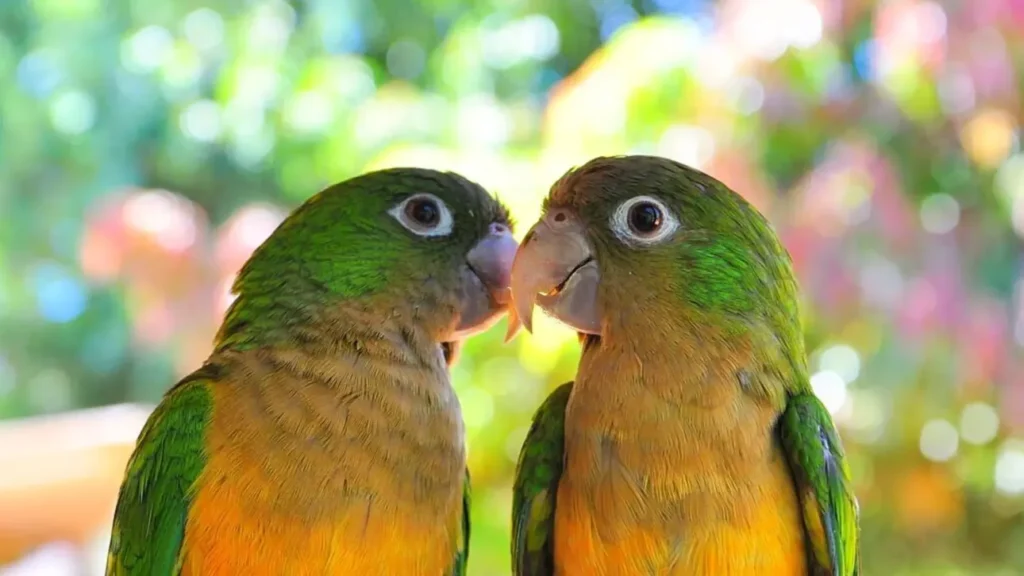
we will explore the traditional beliefs and arguments for keeping lovebirds in pairs. Understanding the reasons behind this practice is essential in the broader debate of whether lovebirds must be paired.
Traditional Beliefs: Why Pairs Are Preferred
The practice of keeping lovebirds in pairs has a long history, rooted in certain traditional beliefs and observations. Let’s delve into why pairs are preferred by some enthusiasts:
Natural Behavior
One primary reason for keeping lovebirds in pairs is their natural behavior in the wild. Lovebirds are observed to form strong bonds with their mates, and they engage in various behaviors such as mutual preening and feeding. It is argued that replicating these natural behaviors in captivity is beneficial for their well-being.
Companionship
Pairs of lovebirds provide companionship to each other, ensuring they are never alone. This constant interaction and presence of a mate are believed to reduce feelings of loneliness and stress in these social birds.
Emotional Fulfillment
Proponents of pairing lovebirds argue that these birds derive emotional fulfillment from being with a mate. It is believed that their emotional needs are better met in the company of another lovebird.
Benefits of Pairs: Companionship and Bonding
In this section, we will explore the benefits of keeping lovebirds in pairs, focusing on the positive aspects of companionship and bonding:
Mutual Care
Pairs of lovebirds are often seen taking care of each other, from mutual grooming to feeding. This mutual care not only strengthens their bond but also ensures that both birds are in good health.
Vocalization
Paired lovebirds engage in vocal interactions, creating a symphony of chirps and squawks. This vocalization is seen as a sign of their contentment and the strength of their relationship.
Breeding and Nesting
For those interested in breeding lovebirds, keeping them in pairs is essential. Paired lovebirds are more likely to exhibit breeding behaviors, build nests, and produce offspring.
Myth vs. Reality: Examining the Conventional Wisdom
While the arguments for keeping lovebirds in pairs are rooted in tradition and observation, it’s important to examine the validity of these beliefs in a domestic setting. In the subsequent chapters, we will explore alternative perspectives and experiences that challenge this conventional wisdom, shedding light on whether lovebirds can thrive as singles or in different social arrangements.
The Case for Keeping Lovebirds as Singles
In this chapter, we’ll explore the case for keeping lovebirds as singles, considering the perspective of those who believe in the benefits of this independent approach. While pairs have their advantages, there are compelling reasons to consider the solo lovebird experience.
Single Lovebirds: The Independent Option
Advocates of single lovebirds argue that these birds can thrive on their own. Here are some key points in favor of keeping lovebirds as singles:
Independence
Single lovebirds are known for their independence. They are self-sufficient and do not rely on a mate for companionship or care. This independence can be a positive trait for those who prefer low-maintenance pets.
Personal Bond
Solo lovebirds often form deep and affectionate bonds with their human owners. They can become incredibly attached and provide their owners with a unique and close relationship.
Reduced Aggression
Lovebirds in pairs can sometimes display aggression towards each other, especially during breeding seasons. Keeping them as singles can reduce the potential for such conflicts.
Bonding with Humans: The Solo Lovebird Experience
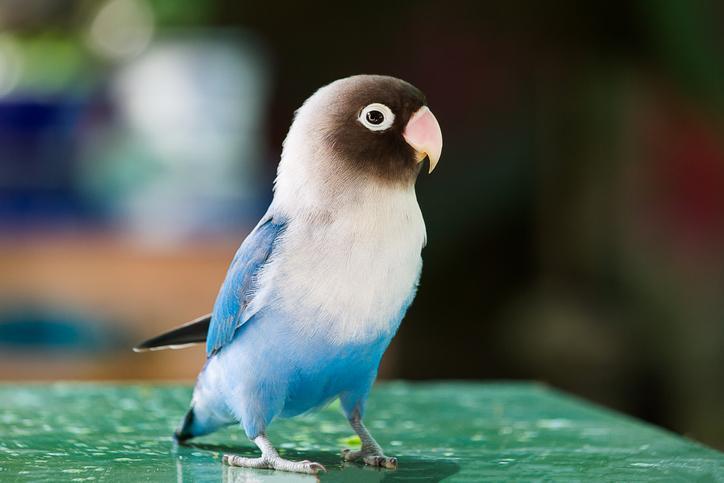
This section focuses on the special relationship that can develop between solo lovebirds and their human caregivers:
Human Interaction
Single lovebirds require human interaction to thrive emotionally and mentally. They often become talkative and engage with their owners in ways that paired lovebirds may not.
Mimicking Behavior
Solo lovebirds are known for their ability to mimic human speech and sounds. Their capacity for bonding with humans and emulating their behavior makes them exceptional companions.
Personalized Care
Owners of solo lovebirds have the opportunity to provide personalized care and attention, tailoring their interactions to meet the unique needs and preferences of their feathered friends.
As we explore the case for keeping lovebirds as singles, it becomes evident that the solo lovebird experience has its merits and can be a fulfilling choice for those who value a strong bond with a single bird.
Lovebird Care and Interaction
When it comes to lovebirds, care and interaction play a crucial role in ensuring their happiness and well-being. In this chapter, we’ll delve into the various aspects of caring for these fascinating birds, especially when they are kept as singles.
Providing Social Interaction for a Single Lovebird
Single lovebirds may not have a mate to socialize with, but they do require social interaction, albeit of a different kind. Here’s how to ensure they remain socially engaged:
Human Companionship
Human companionship is essential for single lovebirds. Spend quality time with your feathered friend, talking to them, singing, and providing companionship.
Playtime and Toys
To keep your lovebird mentally and physically active, provide a variety of toys and activities. Rotate toys regularly to prevent boredom.
Training and Enrichment
Engage your lovebird in training sessions, teaching them tricks or tasks that stimulate their intelligence and creativity.
The Role of the Lovebird Owner in Ensuring Happiness
As a lovebird owner, your role is pivotal in your pet’s happiness. Here’s how you can ensure a joyful environment for your feathered companion:
A Safe and Comfortable Habitat
Create a safe and comfortable living space for your lovebird, with appropriate perches, food, and water. Keep the cage clean and spacious.
A Nutritious Diet
A well-balanced diet is essential for your lovebird’s health. Provide fresh fruits, vegetables, and high-quality commercial bird food.
Regular Health Check-ups
Ensure your lovebird receives regular check-ups from an avian veterinarian to catch and address any health issues early.
Understanding Their Needs
Each lovebird has unique preferences and needs. Get to know your pet’s likes and dislikes, and tailor your care accordingly.
we’ve discussed the critical aspects of lovebird care and interaction, focusing on the needs of single lovebirds. Understanding and addressing these factors are fundamental to providing your lovebird with a happy and fulfilling life.
Expert Opinions and Insights
In the world of lovebirds, there’s no shortage of expert opinions and valuable insights that can help you make an informed decision about whether they should be kept in pairs or as singles. In this chapter, we’ll explore what breeders and avian specialists have to say, as well as share some personal experiences from lovebird owners who have firsthand knowledge of these charming birds.
What the Experts Say: Breeders and Avian Specialists
When it comes to understanding lovebirds and their social needs, breeders and avian specialists are a valuable source of knowledge. Here are some key insights from these experts:
The Importance of Species
Different species of lovebirds may have varying social requirements. Expert breeders can shed light on which species thrive in pairs and which ones can be content as singles.
Behavioral Observations
Avian specialists often conduct in-depth behavioral observations of lovebirds. They can provide valuable insights into the natural behaviors and social tendencies of these birds.
Health Considerations
Experts can guide you on the potential health benefits and risks associated with keeping lovebirds in pairs or as singles. They can help you make choices that prioritize the well-being of your feathered companions.
Personal Experiences: Stories from Lovebird Owners
Sometimes, personal experiences offer a unique perspective on the debate over lovebirds in pairs versus singles. Lovebird owners have their stories to share, each with its own lessons and insights:
Success Stories
Some lovebird owners may have heartwarming success stories of single birds thriving, showcasing the potential for happiness in solo lovebirds.
Challenges Faced
On the flip side, owners may also share the challenges they’ve encountered when keeping lovebirds as singles, offering a more balanced view of the situation.
Tips and Recommendations
Experienced lovebird owners often provide practical tips and recommendations for those considering lovebirds as pets. These insights can help you create the best environment for your feathered friends.
we’ve tapped into the wisdom of experts in the field, as well as the experiences of lovebird owners, to provide you with a well-rounded perspective on the age-old
